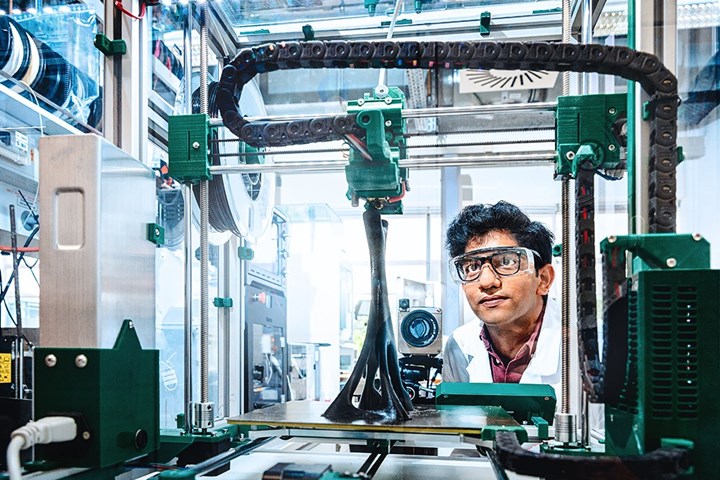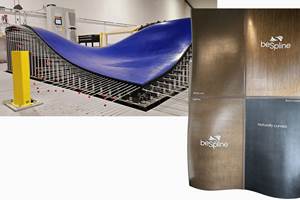Fraunhofer Cluster of Excellence Programmable Materials CPM develops 4D printing technology
The technology adds the dimension of time (1D) to the dimension of space (3D), enabling the shape of predefined, printed polymers to be altered at a later point in time when exposed to heat.

Dilip Chalissery develops the process technology for 4D printing at Fraunhofer IAP. Photo Credit: Potsdam Science Park, sevens+maltry photographers
The Fraunhofer Cluster of Excellence Programmable Materials CPM (Fraunhofer CPM, Freiburg, Germany) has developed a 4D printing technology that can alter the shape of predefined, printed polymers when heated, shrinking them by up to 63%, according to a test performed on rod-shaped samples. Fraunhofer CPM says in the future, such technologies could be used to produce parts that exhibit a specific behavior only after they take their predefined shape, using fasteners in the assembly components in the medical technology, mechanical engineering, automotive and aviation industries as examples.
How does 4D printing work? According to Fraunhofer’s team of researchers, the technology adds the dimension of time, or 1D, to the dimension of space, or 3D. In this way, objects can be printed from shape memory polymers that can change their shape once at a later point in time when exposed to heat. Specific curvatures are also possible in a targeted manner.
“We initially started with a relatively simple rod geometry, but ultimately we were able to produce more complex hollow cylinders and hollow cuboid-shaped samples,” says Dr. Thorsten Pretsch from the Fraunhofer Institute for Applied Polymer Research IAP, who is coordinating the project at Fraunhofer CPM. “For all the geometries we investigated, we specified the desired material behavior in advance.”
There are generally two ways to adjust the response to a temperature increase, researchers note. The first is the choice of material — here the researchers developed a new thermoplastic polyurethane (TPU), with shape memory properties. The team also showed that the findings gained from 4D printing can also be transferred to another thermoplastic polymer: They produced shrinkable printed objects from the bio-based polymer polylactic acid (PLA). The second possibility lies in the management of the printing process.
“The key is that we give the materials very little time to cool down during printing. As a result, drastic internal stresses are stored in the material. The subsequent shrinkage effect is then very pronounced,” says Pretsch. In short, the choice of material, processing temperature and printing speed can be used to adjust not only the shrinkage behavior, but also the curved state.
The first step in the project was to develop the material and transfer the findings from TPU to PLA. The second step was to develop a demonstrator, a door opener that is shrunk onto a door handle so that it can be operated with the elbow without hand contact. Disassembly is simple: By reheating, the door opener detaches from the handle without leaving any residue. When the print object is no longer needed, it can be ground and reprocessed into filament that can be used at least one more time for 4D printing.
“The concept is holistic and future-oriented. In terms of a cradle-to-cradle approach, we have gone through the entire product cycle — from the selection of monomers and polymer synthesis to the 4D printing of a demonstrator and its mechanical recycling,” Pretsch summarizes.
The four Fraunhofer institutes contributed their specific expertise. The Fraunhofer IAP synthesized the shape memory polymer, further developed the 4D printing technology and carried out the mechanical recycling; Linda Weisheit from the Fraunhofer Institute for Machine Tools and Forming Technology IWU developed the concept of programmable stiffness of the 4D materials; and the Fraunhofer Institute for Industrial Mathematics ITWM conducted mathematical simulations to design the demonstrator.
“For example, we investigated how the force is distributed in the door opener when it is loaded. We were also interested in finding out which design is better in terms of material consumption,” explains Dr. Heiko Andrä. The practical tests took place at the Fraunhofer Institute for Mechanics of Materials IWM. “Here, for example, the question was which torques occur when the door opener is loaded,” explains Dr. Tobias Amann.
The results of the project were published in the journal .
Related Content
McClarin Composites partners with ExxonMobil to accelerate high-speed RTM
Multimillion-dollar investment to drive next-gen automated RTM technology will open new applications and markets for composites OEMs.
Read MoreZünd, Loop Technology partner on FibreLine preforming system
Pairing Loop Technology’s automation with Zünd digital cutters provides faster cutting, less stray fibers, higher ply accuracy and more precise preforms for composite aerostructure manufacturing.
Read MorePlant tour: BeSpline/Addcomp, Sherbrooke, QC, Canada
Composites automation specialist increases access to next-gen technologies, including novel AFP systems and unique 3D parts using adaptive molds.
Read MoreOptimizing robotic winding of composite tanks and pipes
Pioneer in mandrel-based reinforced rubber and composite products, TANIQ offers TaniqWindPro software and robotic winding expertise for composite pressure vessels and more.
Read MoreRead Next
Ceramic matrix composites: Faster, cheaper, higher temperature
New players proliferate, increasing CMC materials and manufacturing capacity, novel processes and automation to meet demand for higher part volumes and performance.
Read MoreUltrasonic welding for in-space manufacturing of CFRTP
Agile Ultrasonics and NASA trial robotic-compatible carbon fiber-reinforced thermoplastic ultrasonic welding technology for space structures.
Read MoreCutting 100 pounds, certification time for the X-59 nose cone
Swift Engineering used HyperX software to remove 100 pounds from 38-foot graphite/epoxy cored nose cone for X-59 supersonic aircraft.
Read More












